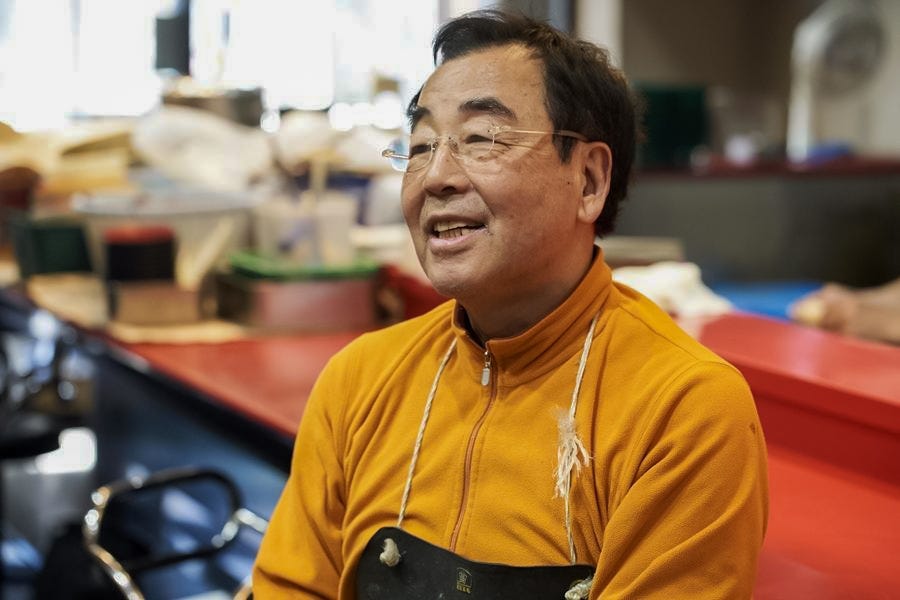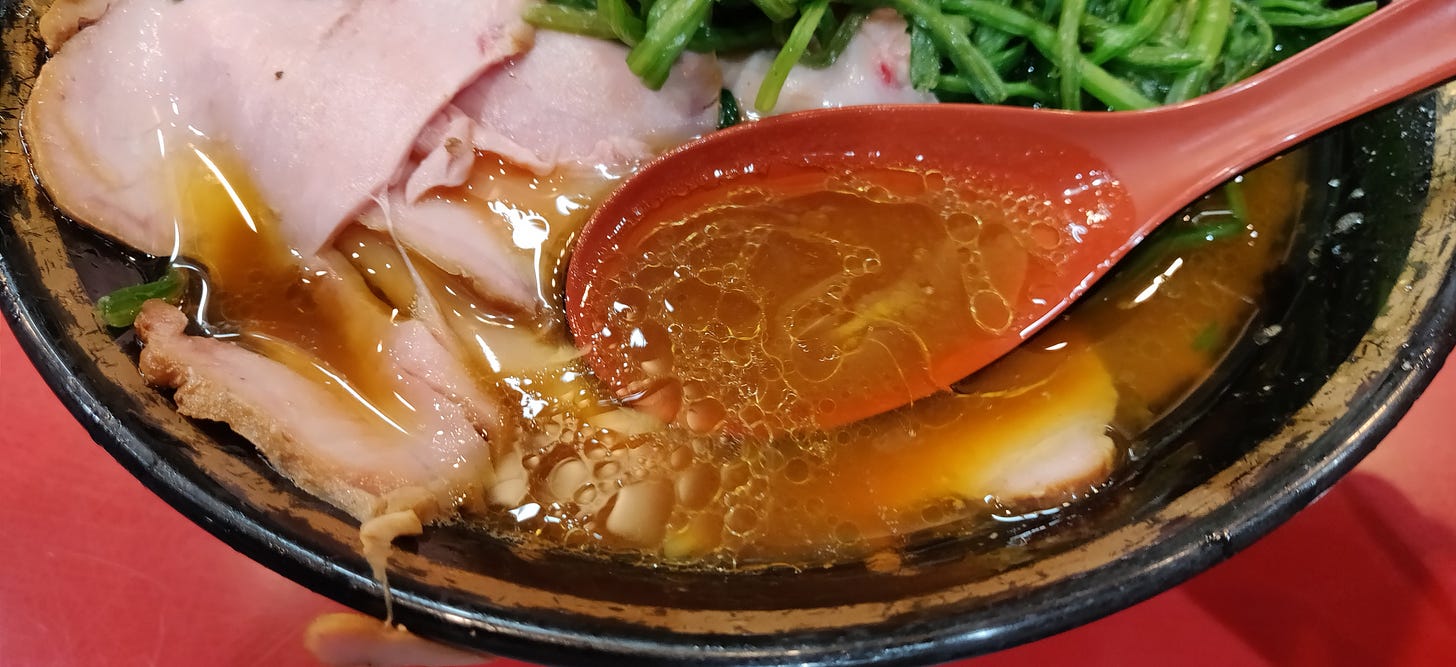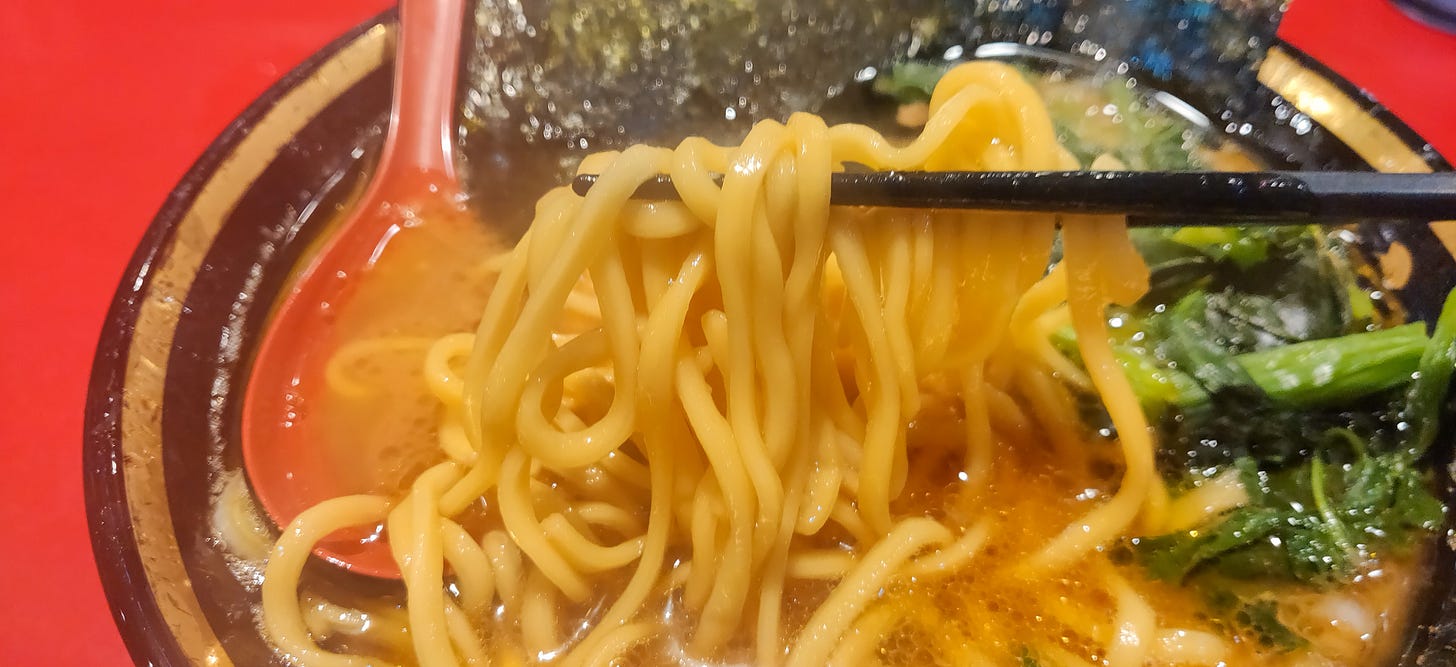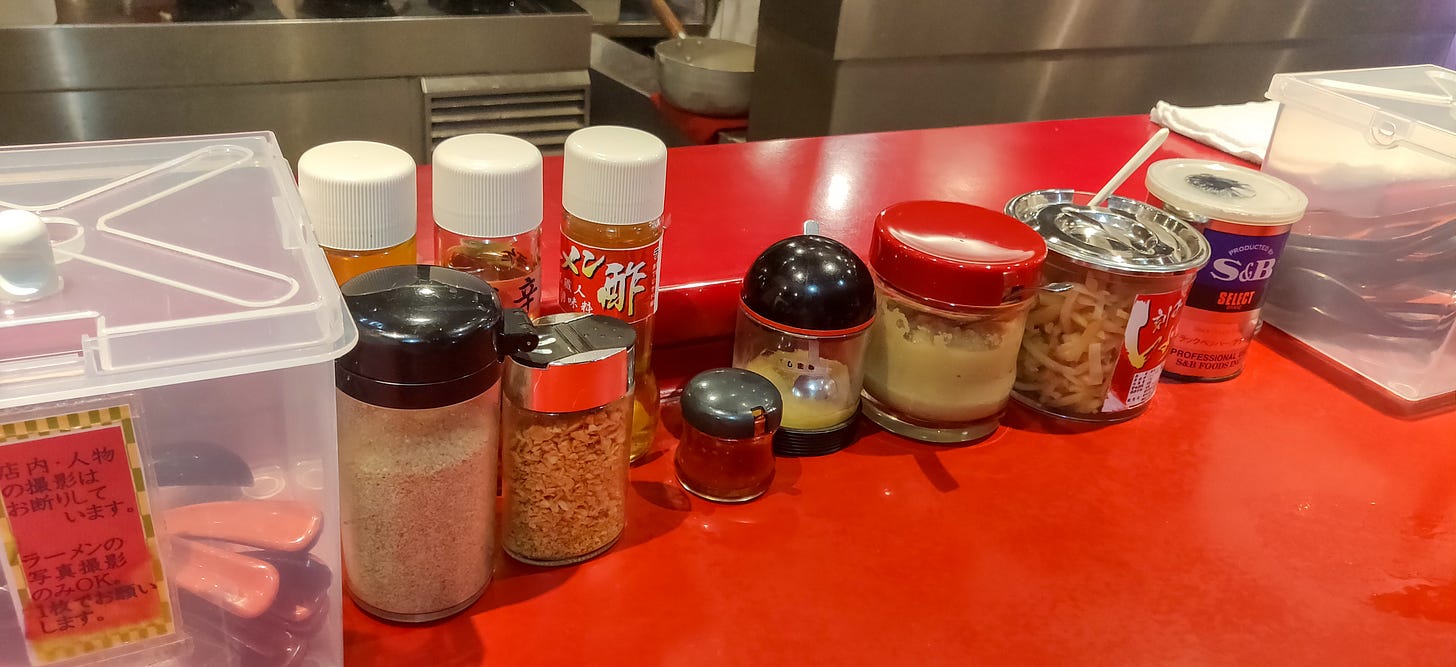The Delicious, Murky History of Iekei Ramen
Part I of Ramen Beast's deep dive into one of Japan's most popular but critically under-appreciated ramen varieties.
Yokohama Iekei is a variety of ramen that many visitors to Japan have probably tried without even really knowing what they were eating. A blend of two of Japan's great ramen genres — Hakata-style tonkotsu (creamy pork soup) and Tokyo-style chicken shoyu — it's the ultimate blue collar crowd pleaser. But it's also something of an enigma.
A victim of its own success to an extent, the style has become so ubiquitous in Japan that its quality varies wildly — so much so that a lot of self-flattering foodies might even scoff at grabbing a bowl of Iekei today. Yet older ramen heads tend to hold the genre in high regard, recognizing the pillar-like role it has played in the popularization of ramen culture, and insisting that you just need to know where to go to get the best fix.
And there are other mystifying aspects... Many of Japan's most influential ramen varieties tend to be closely associated with the Japanese prefecture in which they originated, such as Hokkaido's famed miso ramen, or Fukuoka's beloved Hakata tonkotsu. In these cases, if you want the best of the best of this genre, you must go to the source. Iekei should be no different: The style is intimately linked to its humble beginnings in Yokohama, Tokyo's densely populated neighbor city to the southwest. Nowadays, though, ramen hunters in the know will tell you that the best Iekei shop out there isn't even located in Yokohama — the Mecca has shifted to Ramen Hiiki, located in the Kamata district of southern Tokyo (more to come about this shop).
So this week in the Ramen Beast newsletter, we have set ourselves the task of untangling the murky history and persistent appeal of this somewhat controversial and disrespected ramen varietal — coming down firmly in the camp that insists Iekei is delicious as hell.
This is Part I of our Iekei Ramen deep dive… Ramen Beast’s Cody Mizuno just kept digging and we ended up with way more Iekei lore than could possibly fit into one newsletter. So if you enjoy this one, keep an eye out for Part II over the next day or two, where you’ll learn about an ongoing battle between two Iekei shops, and more on the inspiring blue collar roots of the dish.
If you’re new here, this is the Ramen Beast Newsletter — stories and explorations of Japan’s vast ramen subculture. Subscribe, share or email us with your ramen queries.
To get things rolling, here's Abram's personal riff on Iekei Ramen:
Amongst the more serious ramen heads, Yokohama Iekei is a style that tends to be somewhat overlooked and under appreciated. Considering it's one of the most popular and well-known styles of ramen in Japan, you might be wondering how that could be true. I mean, almost everyone loves Iekei, and it can be found anywhere in the country. But that's the thing... because it's so mainstream, so prevalent, and so watered down, it doesn't get the respect it sometimes deserves. Truth be told, this is a style where chain shops and copy cats have decimated the landscape. You can be in the middle of nowhere, driving down a coastal road in say, Miyazaki Prefecture, or Hokkaido, and BOOM! A Yokohama Iekei shop pops up like an eyesore on the side of the road. Why an eyesore? I don't know, but just so many Iekei shops have that chain-like, box store, cookie cutter vibe to them. Like there's no soul in the restaurant and the food; it's just a bowl to fill you up. Business ramen. But you know what? Quite often these shops are fairly busy with customers. Of course, to the sophisticated ramen palette the majority of these shops aren't that great; but to be honest, they aren't that terrible either. Iekei is a style that is duplicated well. It's all chicken and pork based, and the recipes and methods are not as complicated as some of the delicate fish and seafood broths out there. And to people all around, it flat out tastes good. Creamy tonkotsu soup, rich chicken oil. Medium width noodles cut on the short side, easy for all to eat. And the customization! Oil, tare and noodle firmness levels can all be modified when you order, and a wide array of condiments and toppings are supplied on the counter for free. For sure, Iekei is a style in which the subtle differences are often masked by a shower of customer condiment choices. But everyone has their favorite way to prep an Iekei bowl.
I myself, have been guilty of under-appreciating Iekei. The same way that Hakata tonkotsu grabs you the first time you experience it — it's usually the style most appealing to first-time foreign visitors to Japan — Iekei is awesome at first, only to be left behind in the dust once your palette develops and you discover the countless other styles of ramen. In the current era of premium ingredients, delicately placed toppings, and masters constantly trying to raise the bar by incorporating new ideas and methods into their creations, Iekei kind of sits off to the side, in its own little world. The same can be said of Ramen Jiro, of course, which we analyzed a few weeks back, and while taking this deep dive into Iekei I realized just how many similarities there indeed are between the two genres. Yet at the same time, they are very different beasts. Jiro style is polarizing, over the top, in your face, more than you can handle. It's explosive — an almost violent food experience. Iekei is none of that. When done right, it's just a damn good-tasting bowl of ramen, that goes great with rice, great with nori seaweed, great with ginger, great with garlic, great with spice. It's not heavy in the way many bowls of tonkotsu make you feel. Proudly blue collar, it's a style beloved by all.
Iekei's Origins
Iekei was invented in 1974 by former truck driver Yoshimura Minoru (吉村実) near Shin-Sugita station, about 20 minutes south of Yokohama. During his truck driver days, Yoshimura-san became obsessed with trying out Japan's various prefectural ramen styles during the course of his long-haul drives across the archipelago, tasting hundreds of regional bowls during his journeys.
As legend has it, one day Yoshimura-san came upon a seemingly obvious but untested revelation: What would happen if you combined the creamy pork broth of Hakata-style tonkotsu with the clean chicken and shoyu soup of classic Tokyo-style shoyu ramen? Convinced that the combo would unite Japan's rival ramen cultures into a bowl beloved by all, Yoshimura-san quit his job and took on an apprenticeship at a branch of the influential chain "Ramen Shop," determined to make his revelation a reality.

After picking up some chops at Ramen Shop, Yoshimura-san launched his now legendary shop, Yoshimura-ya, near Shin-Sugita station. The ramen he served was precisely the blend he dreamt up just a year before. The hybrid took root almost instantly, attracting long lines and becoming known colloquially as "Iekei" — the start of a ramen phenomenon.
The Ramen
So what is Iekei Ramen? As mentioned, the soup is best described as a tonkotsu shoyu blend — soup made from boiled pork bones and torigara (chicken carcasses) — and it comes served with short, straight, semi-flat noodles. The tare is shoyu, of course, and you're unlikely to find other tare seasoning variants — at least among Yoshimura-san's official disciples’ shops.
The soup has an unmistakably rich flavor profile, but it's not quite as creamy as a Toripaitan (鶏白湯) or Hakata (博多) style ramen. While the soup is quite emulsified, it is not unusual to find a nice layer of oil floating on the surface encapsulating the heat and flavors underneath. This golden goodness is chiyu, or chicken oil. The presence of the chiyu is undoubtedly one of the reasons behind the genre's popularity. If you order extra chiyu — at no extra charge — expect to see a nice 1-2cm thick coating of delicious, flavor-rich chicken oil floating at the top of your soup.
Produced off site, Yoshimura-ya's noodles are made by the old school noodle company Sakai Seimen (酒井製麺), which is located near Kamata station in Tokyo. The strands are typically short and flat, which helps act as a vessel for the soup. One of the sticking points for all shops run by Yoshimura-san's disciples is access to Sakai Seimen's noodles. Working with Sakai Seimen to produce Yoshimura-ya's signature noodle recipe for your shop requires getting Yoshimura-san's personal blessing. Other spin-off Iekei shops and imitators serve very similar flat, short noodles, but Iekei diehards swear by Yoshimura-ya’s secret recipe. Precisely what makes the original noodles so special is a little difficult to parse, but it appears to be related to the way that they don't soak up a lot of water as they're cooked, leading to a more pleasant texture and consistency regardless of whether you order them soft, regular or al dente. They're hardy and delicious, every time — like all things Iekei.
When it comes to the actual cooking, Yoshimura-ya, and most Iekei shops, are famous for the use of the hirazaru (平ザル), or flat colander, when performing the yugiri (湯切り), or straining of the noodles. While many shops these days use a more tubular-shaped colander, Yoshimura-san believes that the hirazaru drains the water from the noodles best, while preventing any damage to the noodles before they are placed into the soup. Others will say that the hirazaru is best because it allows ample room for the noodles to boil when cooking in a big cauldron. Whatever the theory, this tool is common in many of the legendary tsukemen shops, ala Marucho and Taishoken, as well as at Jiro locations.

Toppings and Sides
The toppings and customization options of Iekei are what makes it so special for many longtime fans. Typically, the bowl will be garnished with some spinach, dried seaweed, and a few slices of smoked pork chashu. Additional toppings like eggs, wood ear mushrooms and cabbage, which help soak up the decadent soup, are usually available for additional purchase. Honestly, all of the toppings act more like a vessel to get more soup into your mouth rather than providing another layer of flavor development, but this is exactly what makes Iekei so great. The soup should be the main attraction at any Iekei shop and everything else is there to help you enjoy their liquid gold. Garnish with pre-ordered additional toppings for texture and contrast.
Once your bowl arrives, you first want to taste a bit of the soup to see if you feel that it needs adjusting. If you feel it is missing something, customers are encouraged to customize their ramen as much as they like with the free toppings that are always arrayed on the counter. Options always include grated garlic, grated ginger, pickled ginger, sesame seeds, chili paste, vinegar and ground pepper. Often there are several other toppings or condiments to try. The concept of these free toppings most likely stems from Yoshimura-san’s training at “Ramen Shop” which also offers table condiments. A number of shops have a “recommended” way to prepare the bowl with the free toppings provided at the table. For instance, at Sugita-ya, they recommend a shake of ground black pepper, half a clove of minced garlic, and a small spoonful of spicy miso. When in doubt, observe and imitate the regulars around you.
Some believe the concept of ajihen (味変), or flavor change, became widely popular in ramen thanks to Iekei shops, simply due to the sheer amount of seasonings provided at the table. The idea of ajihen is to subtly change the flavor profile of the ramen throughout the course of the meal, so that your bowl remains an evolving eating experience until you’ve finished the last drop of soup. Longtime eaters acquire their own skills and styles of ajihen.
By far the most frequently deployed of the table toppings is the grated garlic, with most patrons adding a couple spoonfuls to their bowl. The garlic is so popular that many customers believe it’s essential to a well-rounded bowl of Iekei. But apprehensions about garlic breath became a natural concern at Iekei shops early in the style’s evolution. Seeing his customers' unwillingness to add garlic if they had a business meeting or a date planned after their meal, Yoshimura-ya began providing a type of garlic he pioneered which allegedly delivers flavor but doesn’t cause bad breath. You’ll find this mysterious option at most shops. Master Yoshimura later added yet another garlic variety as a topping option. You’ll notice a green-hued garlic paste on most Iekei counters. This is a tangy breed of garlic chive from Hokkaido that gets mashed together with its green shoots, giving it a slightly greenish color (on the left in the photo above).
Fresh rice is almost always offered on the menu in Iekei shops and regulars will without fail order a portion with their ramen. Rice is life for Iekei and customers tend to eat the ramen as a compliment to it, rather than the other way around. Some shops will even offer rice for free because of how iconic the pairing is. Order a bowl and enjoy the balance of alternating between the rich, flavorful soup and the clean Japanese white rice. You’re tasting one of the grassroots masterpieces of late 20th-century Japanese cuisine.
Coming soon: Part II of Ramen Beast’s Iekei Ramen exploration… Iekei battles, the Iekei popularity explosion, and where that weird name comes from…
- Edited by Patrick Brzeski, produced collectively by the Ramen Beast team.















Looks good man!